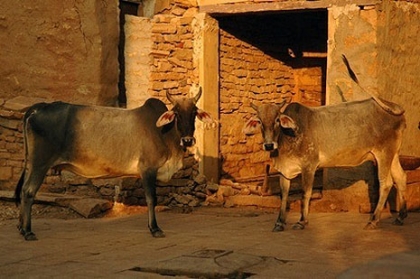One advantage of being born in a ‘developing’ nation and moving to a ‘developed’ one is the viewpoint it gives me on both worlds. Often, this sensibility cannot be defined by a ‘logical’ analysis alone. I have seen a curious and often comical pattern in some of my American and European friends’ attitudes about India.
A frequent topic of amusement is the issue of street cows on Indian roads. We often engage in discussions about this urban Indian curiosity. "So why DO you have cows on the roads?" they ask, followed by an incredulous look. It’s easy to use the defensive religious stance, mentioning the Hindu masses of India to whom this is a sacred animal, who often engage in the worship of the cow and demonstrate an elaborate tolerance towards the bovines. But then again, it’s probably my attempt to logically explain the functioning chaos that India is.
Last year, on a Delhi winter morning during my annual trip there, I found myself sitting at one of the roadside dhaba (street vendors) having a cup of masala chai tea when it all came to me. Outside of all the animal rights, health care and traffic safety agendas, one can't help notice a simple, base-level sustainable mechanism at work on the streets of India – a symbiotic collaboration between the street vendors and the cows. For years, the Indian government has tried to control the free roaming cows in urban areas, but their efforts have been in vain. Are there vested interests at play here or are the slow moving bovines creatures stealthily dodging the hands of the law?
Yes, the animals’ owners obviously benefit from the cows’ free range because it saves them the overhead of traditional husbandry, but it begs the question – why don’t the urban citizens object? It may well be the religious sentiment surrounding their existence which allows them special status, or it may be that the creatures have developed a symbiotic relationship with the people who interface with them the most – the street vendors.
I slurped up my masala chai served in the terracotta cup and crushed it into the dirt on the side of the street for the winds and earth to claim. I then moved to a chat (savory fast foods) vendor. I couldn’t help but notice a huge, mellow cow standing patiently a few yards away. Vendors crowd the streets in Urban India – there is never a shortage of options in the land of the hungry and poor. To quote Anthony Bourdain, Chef and host of Travel Channel TV series No Reservations, “To judge the level of entrepreneurship in a country one just needs to count the number of vendors at any street corner in any urban setting.” Some of the major street corners of urban India host up to 10- 20 street vendors. If India is poor, lacking the food to feed its masses, then how does it manage to feed all those cows on the streets which are obviously thriving?
I noticed the venders serving their mostly vegetarian food on plates made of the sal and siali leaves commonly used in low income economies. Once used, the plates are discarded in a heap behind the vendor. This provides the cow with a constant supply of fodder with the particular flavoring of the vendor it chooses. Not only does the cow remove leftovers of the vendor at the end of the day, it also prevents the vendor from reusing them to save a penny. No detergent, no water, no washing.
Once the plates are digested they are recycled into another valued resource. The hot, dry Indian climate converts cow dung into dried cow dung cakes in a matter of one afternoon. These cakes are then collected by the poor people who move from villages to urban slums in hope of finding daily wage work. So the dung cakes are scooped up for use in chullahs (a primitive cooking stove), which run fantastically well on the sun-dried, dung cake fuel.
Does one view these mechanisms which have evolved to balance inefficiencies of bio waste disposal as ‘broken infrastructure?’ Or should we design and install trash cans which remove the cow’s better ergonomics from the cycle, and create two new streams of pollution where none existed before?
Or does one study this evolutionary infrastructure of sustainability in minute detail and design NEW systems leveraging what it has to teach us, rather than imposing a business model fit for another context and another world?
Here’s my curious perspective: often the ‘developing world‘ has solutions that may look like mistakes, but are actually clever and quite complex holistic adaptations.
Even if it does involve a moo-ing trash receptacle.
Image credit: ©Tatiana Nazarova – Fotolia.com

